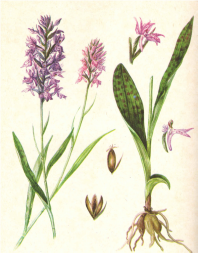FAMILY ORCHIDACEAE
Small perennial herbaceous plants with tuberous roots or rhizomes. Leaves are simple with parallel venation. Flowers are solitary or arranged in racemes. Flowers are irregular, with a petal-like perianth consisting of 6 segments. Three outer segments are free and directed upwards. The middle of the three inner segments is distinctly different in size, shape, and often color, forming a «lip» («slipper»); in some genera, the lip extends into a long hollow spur. Due to the ovary’s twisting, the lip is oriented downward. There is usually one stamen (rarely two), fused with the style into a column, while the other two stamens are reduced to small staminodes. Pollen does not scatter from the anther but clumps into masses called «pollinia» within each cell. The ovary is inferior. The fruit is a capsule containing numerous very small seeds with underdeveloped embryos, so reproduction is predominantly vegetative. Flowers can only be pollinated by specially adapted insects, with the lip serving as a «landing platform.»
Small forest orchids of the genera Orchis, Platanthera, Gymnadenia, and Anacamptis have medicinal significance.
The tuberous roots of these genera are rich in starch and mucilage, with bundles of raphides in the mucilaginous cells. Leaves sometimes contain coumarin derivatives, and flowers have fragrant glycosides. The genus Cypripedium contains a caustic substance. No alkaloids or tannins have been found.
These small plants have fibrous roots, one of which stores nutrients and forms a juicy storage tuber. In spring and summer, the stored nutrients are consumed for the development of the aerial parts, causing the tuber to deplete and die off. However, a new storage tuber forms in the axil at the base of a leaf in spring, overwinters, and supports the plant’s growth the following year. The tuber’s shape is oval or palmate. Leaves are simple, basal, or stem-attached. The stem bears a terminal raceme. Flowers are lilac-colored with a three-lobed lip and a long spur. All species of orchids can be used for collecting tubers.

The Pharmacopoeia VIII includes the following species: Orchis latifolia L, Orchis maculata L, Orchis mascula L, Orchis militaris L, and Orchis morio L.
Orchids grow in moist areas of forest glades and edges, found throughout the forest zones of the European part, Siberia, the Far East, and the Caucasus. Similar tuberous roots are present in some other genera, which are also harvested.
